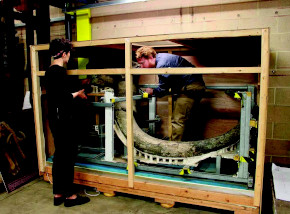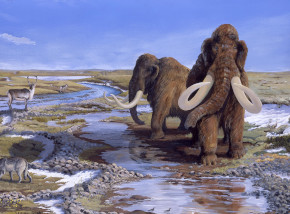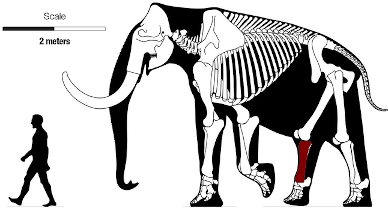.jpg) The discovery of the West Runton Mammoth, was first made in 1990, when local residents Margaret and Harold Hems were walking along West Runton beach and they saw what looked like a large bone sticking out from the cliff face. After contacting Norfolk Museums Service, it was identified as a pelvic bone of a large Steppe mammoth.
The discovery of the West Runton Mammoth, was first made in 1990, when local residents Margaret and Harold Hems were walking along West Runton beach and they saw what looked like a large bone sticking out from the cliff face. After contacting Norfolk Museums Service, it was identified as a pelvic bone of a large Steppe mammoth.
A year later a local fossil hunter called Rob Sinclair discovered more large bones and an exploratory excavation took place, followed by a serious three-month long excavation in 1995, carried out by Norfolk Museums Service with the Norfolk Archaeological Unit.
 The exploration unearthed 85% of a mammoth skeleton, the most complete skeleton of a Steppe mammoth ever found in Britain. The majority of the West Runton Mammoth is in special storage at the Norfolk Collections Centre at Gressenhall Farm and Workhouse (where regular public tours are put on), but there is a dedicated display at Cromer Museum as well as a small display in Norwich Castle Museum.
The exploration unearthed 85% of a mammoth skeleton, the most complete skeleton of a Steppe mammoth ever found in Britain. The majority of the West Runton Mammoth is in special storage at the Norfolk Collections Centre at Gressenhall Farm and Workhouse (where regular public tours are put on), but there is a dedicated display at Cromer Museum as well as a small display in Norwich Castle Museum.
You can also find out about the Deep History Coast at Sheringham Museum.
TOP FIVE WEST RUNTON MAMMOTH FACTS
.jpg) The West Runton Mammoth was a Steppe Mammoth and an ancestor of the Woolly Mammoth, but could perhaps be more accurately described as the Giant Forest Mammoth. The remains of the West Runton Mammoth were found in what is known as the Cromer Forest-bed Formation West Runton, a 1.5m-thick layer of organic-rich mud which was deposited during the Cromerian Interglacial about 700,000 years ago, long before the last ice age. This deposit is full of all sorts of fossils, ranging from thousands of small snail shells, twigs and small mammal bones, through medium sized deer, horse and rhino bones to the huge bones of elephants that roamed our country in herds back then.
The West Runton Mammoth was a Steppe Mammoth and an ancestor of the Woolly Mammoth, but could perhaps be more accurately described as the Giant Forest Mammoth. The remains of the West Runton Mammoth were found in what is known as the Cromer Forest-bed Formation West Runton, a 1.5m-thick layer of organic-rich mud which was deposited during the Cromerian Interglacial about 700,000 years ago, long before the last ice age. This deposit is full of all sorts of fossils, ranging from thousands of small snail shells, twigs and small mammal bones, through medium sized deer, horse and rhino bones to the huge bones of elephants that roamed our country in herds back then.
 There have been many species of elephant living in England over the last few millions of years. The West Runton Mammoth, living when the Freshwater Bed was laid down, was the Steppe Mammoth Mammuthus trogontherii.
There have been many species of elephant living in England over the last few millions of years. The West Runton Mammoth, living when the Freshwater Bed was laid down, was the Steppe Mammoth Mammuthus trogontherii.
It is a very early mammoth, which is a type of elephantid. It was the descendants of this species that became what we call the 'woolly mammoths' that lived in the colder conditions of the ice ages and were a lot smaller.
.jpg) The mammoth would have fed on grass, herbaceous shrubs and other vegetation in an open forest and grassland environment. We know from the small mammals and the pollen from the plants that at the time the West Runton Elephant lived the climate was exactly the same as today.
The mammoth would have fed on grass, herbaceous shrubs and other vegetation in an open forest and grassland environment. We know from the small mammals and the pollen from the plants that at the time the West Runton Elephant lived the climate was exactly the same as today.
Although the list of animals living with the elephant sounds exotic, this is because we have lost these species due to hunting and the effects of the relatively recent ice ages, not because the climate was any different back then.
.jpg) Standing at least four metres at its shoulder, the West Runton Mammoth would have weighed about ten tonnes, twice the weight of any African Elephant. It is known that the mammoth was a male who died at about the age of 42 (he would normally have lived to his sixties) in a fresh-water river bed.
Standing at least four metres at its shoulder, the West Runton Mammoth would have weighed about ten tonnes, twice the weight of any African Elephant. It is known that the mammoth was a male who died at about the age of 42 (he would normally have lived to his sixties) in a fresh-water river bed.
The mammoth skeleton is the largest ever found in Britain. It is also the oldest to have been found in the UK (although some older individual teeth and bones exist).
 This was the largest species of elephant that has ever lived, and the largest animal ever to have lived on land except for the very biggest dinosaurs.
This was the largest species of elephant that has ever lived, and the largest animal ever to have lived on land except for the very biggest dinosaurs.
Other animals around at that time included spotted hyaenas, giant beaver, extinct big cats, extinct species of rhino, extinct giant deer and and other deer.
.jpg) The presence of a distorted distal right femur indicates that the West Runton Mammoth was severely disabled, and probably died as a result of not being able to get up after slipping in mud. Several of the bones have tooth marks on them, and Spotted Hyaena (Crocuta Crocuta) droppings were also preserved – indicating that scavenging took place. Some bones are crushed – the result of trampling after death (probably by other mammoths). Had the skeleton not been found at West Runton when it was, the sea would have destroyed it within just a decade. Find out more at the West Runton Discovery Point on the Discovery Trail and by downloading the free app.
The presence of a distorted distal right femur indicates that the West Runton Mammoth was severely disabled, and probably died as a result of not being able to get up after slipping in mud. Several of the bones have tooth marks on them, and Spotted Hyaena (Crocuta Crocuta) droppings were also preserved – indicating that scavenging took place. Some bones are crushed – the result of trampling after death (probably by other mammoths). Had the skeleton not been found at West Runton when it was, the sea would have destroyed it within just a decade. Find out more at the West Runton Discovery Point on the Discovery Trail and by downloading the free app.
Related
Comments
Comments are disabled for this post.







